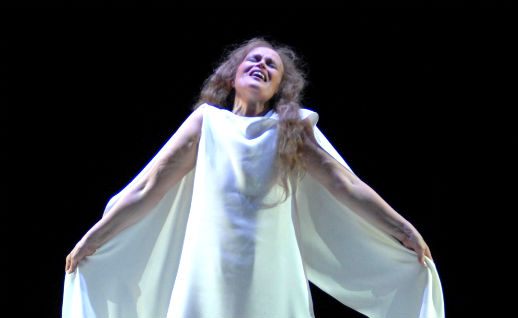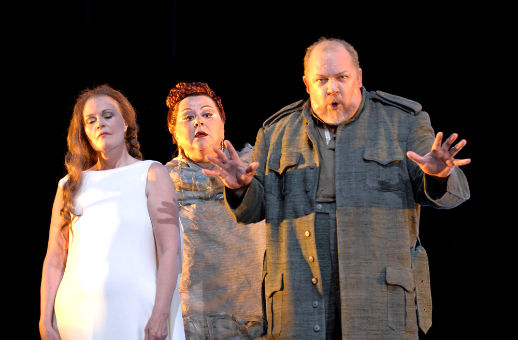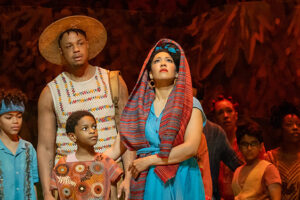

The Théâtre royal de Liège is undergoing a renovation until 2012. In the meantime staged operas take place in the so-called Palais Opéra. This “palace” turned out to be a circus tent without stripes, located in a less attractive area of the city. It’s certainly not as glamorous as the gorgeous art deco Forum, where la Anderson made her sensational Liège debut in a concert performance of Lucrezia Borgia in 2009.
Nevertheless, despite the dreary location, the same buzz of excitement that preceded her Lucrezia at the Forum was discernible last night too. Always a good sign!
The Palais does not have a deep orchestra pit. Instead, the orchestra is simply placed in front of the stage, only slightly beneath it. It was fun seeing the orchestra members waving to relatives, and getting up and kissing friends and family over the low fence, but I was a little worried how on earth the voices, in particular that of Salomé, would travel past that big open pit.
As the title already indicates, Salomé was performed in French. Strauss was very keen on getting his opera staged in Paris, so a lot of time was spent adapting the French text by Oscar Wilde to fit his work. The French version did play in Brussels and in Paris for a short while, but was quickly replaced in those cities by the German version, and soon forgotten. It was barely known to exist until Kent Nagano recorded it with Karen Huffstodt and José van Dam in 1990.
The Liège Salomé, seen June 7, is co-owned by the Opéra de Monte-Carlo and the Vienna Volksoper. The staging by Marguerite Bori is traditional and inoffensive. We see a moon and a palace, and a cistern is suggested by clever lighting—what more do we need?
The opening scene was played behind a see-through curtain, which not only blocked most of the view, but also drowned out the voices. What was clear from the beginning is that the Palais has excruciatingly bad accoustics—no singer in the first scene could be heard well over the loud and very exciting orchestra conducted by Paolo Arrivabeni.
Anderson made her entrance looking as elegant as it is possible look when covered in layers and layers of textile. This turned out to be the concept of Bori—she uses clothes to make her point. According to the booklet, clothes weigh on people, but they also protect them, and at the same time can cover and uncover what people really are like underneath.
Anyhow, Anderson was visibly relieved to shed the first of many garments of the evening. Her voice suffered mostly from the bad accoustics and the loud orchestra. Lower lying passages barely reached the third row where I sat. Her upper register was much clearer, and very beautiful still, except when she chose, for effect, to make it a little shrill. What struck me too is how youthful she sounded, how seductive and how free. She obviously had given up any worries whether or not she could be heard by the audience and sang the part without forcing even once. This meant that not all of it could be heard, but at least she did not tire and what could be heard was very effective.
Her physical portrayal of Salomé was all about moving. By looking at her arms you could tell how she felt. She hid her arms behind her back, in the classic spoiled little girl pose or leaning seductively on a doorpost. She has obviously given this a lot of thought, and it worked fabulously. It all lead up to a most convincing dance, choreographed by Darren Ross. She started the dance slowly, with lots of those elegant arm movements, then proceeded to the “palace,” finally vigorously bouncing into every other character in the opera, including the quarrelling Jews. That last bit looked like it came straight out of Hair.
The Hérodiade of Zampieri was ghastly, firing off sequences of hooty, meaningless sounds without shape or rhythm. Her lines just led a life of their own, with no relation to the music, thus disturbing every scene she was in. Donald Kaasch, on the other hand, was a phenomenal Hérode, revolting in both voice and manner, really scary. Vincent Le Texier was the beautiful and experienced Jochanaan.
During the performance, a continous and very heavy fall of rain caused a disturbing noise in the “palace,” interrupting midway Anderson’s closing scene, which was magical, the highlight of the evening. Here, Arrivabeni worked most closely with the soprano, and toned down the orchestra a little to help her out. The final lines were superb, coloured with morbidity and longing, but still very beautiful. Shedding her final garment, Anderson was left wearing a sheer robe through which you could see the contours of her naked body as she descended into the cistern to meet her fate. This Salome not only sounded half her age, she looked it as well.

























Comments